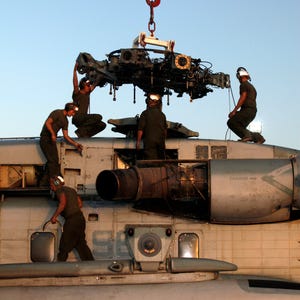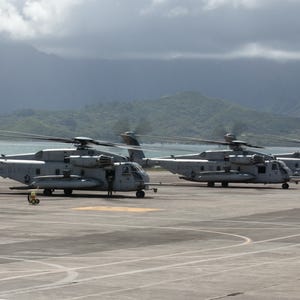Top Marine aviator: Low readiness rates not to blame for crashes
Jeff Schogol, Marine Corps Times
The Marine Corps’ top aviator does not believe serious aircraft accidents are linked to readiness and training shortfalls — but he’s still concerned about the amount of time young pilots are spending in the cockpit.
Lt. Gen. Jon Davis, the head of Marine Corps Aviation, told members of Congress on Wednesday that there’s no tie between the low readiness rates and Class A aviation mishaps that result in the loss of life or damage greater than $2 million.
“Even though my gut sense says there’s something there,” Davis said, “I can’t tie it to the data right now.”
As the father of two Marine pilots, though, Davis said he’s worried Marines could face greater risks in the air since the shortage of flyable aircraft limits how often they can fly training missions.
“I worry about my young aviators that aren’t getting the number of [flight] hours they need to,” Davis said. “I remember as a young guy, I had a couple close calls. I do not know how I would do having the amount of flight time that my youngsters get.”
Marine aviation deaths hit a five-year high last fall when a CH-53E Super Stallion crashed near Camp Lejeune, North Carolina, killing one Marine. On Jan. 14, two CH-53Es crashed off Hawaii, killing 12 Marines.
Davis said the Marines in Hawaii were proficient, but likely required more training before they could fly in combat, adding that they were doing “a pretty straightforward mission that night.”
“Here’s what I worry about the most: That crew was safe, but that crew could have been a lot more proficient at a combat mission that it is on task to go execute,” Davis said. “So I don’t know how well trained they would be to go fight the high-end fight.”
Facing severe budget cuts in recent years, shortages of spare parts and a nonstop demand for combat aircraft, readiness rates for Marine Corps aircraft have plunged while the number of aircraft accidents has been on the rise.
Since October, the Marines have recorded five Class A mishaps, said Capt. Sarah Burns, a Marine spokeswoman at the Pentagon. The latest accident happened on May 6, when a pilot with Marine Attack Squadron 542 safely ejected from an AV-8B Harrier II off the coast of North Carolina.
But the number of Class A mishaps has remained fairly constant in recent years, Davis told reporters after the hearing before the House Armed Services Readiness Subcommittee.
“If you look at pure data — and every mishap is unique and different — we’re about where we were three, four years ago,” he said.
Budget cuts and training shortfalls
The spike in aviation deaths has prompted the Marine Corps to look into whether lower readiness rates caused by budget cuts were leading to more accidents.
“We know historically that if you don’t have the money and you don’t have the parts and you don’t have the maintenance then you fly less,” Assistant Commandant Gen. John Paxton told members of the Senate in March.
Rep. Rob Wittman, R-Va., asked Davis Wednesday if shortfalls in training and readiness could have contributed to the January crash off Hawaii.
Davis made it clear that he did not want to “get out in front” of the investigation into the January crash, but added that they believe the aircraft involved were sound and well maintained.
“We don’t know what happened out there — I won’t know until that investigation that comes out,” he said. “I grieve for every one of the families. That’s the hardest part for me. I’m the deputy commandant for aviation and I lost 12 great Marines.
“That’s what I think about every day.”
The CH-53E fleet has low readiness rates due in part to a problem getting parts, Davis said. It will take until 2019 or 2020 to get enough CH-53Es flying.
Overall, readiness is improving, though, the general said. Right now, the Marine Corps can launch 443 aircraft out of a required flightline inventory of 1,065 fixed- and rotary-wing aircraft, he said. That means about 42 percent of the Marine Corps’ aircraft is currently flyable, compared with 33 percent in March.
Most non-deployed Marine air crews get between seven and 11 flight hours a month, Davis said. While that’s an improvement since March, it is still six hours per month short of what trained and ready crews need.
“There is risk there by not flying and not building that experience out there,” he said.
While Davis does not see a correlation between readiness and Class A mishaps, he is concerned in a dramatic increase in Class C mishaps, which involve between $50,000 and $500,000 of damages or an injury that requires someone to take more than one day off. Such accidents have doubled in the past year, he said.
“I don’t know the reason for that,” Davis told reporters. “If you are getting your airplanes ready at the last possible minute to get out the door for deployment, there’s a wear and tear on the fleet, a wear and tear on the enlisted Marines and officers to get ready. We are going to look at that in great detail.”
Davis has ordered an outside review into what is causing ground mishaps, such as accidents that happen when aircraft are taxiing or being towed.
“What I’ve asked this team to look at is not just the cost of doing that but what’s the loss in readiness from having an airplane not available to train or fly in because we’re fixing it,” he said. “These are the very best Marines we’ve had in the Marine Corps, so if they’re making mistakes, why?”
Back to Top



